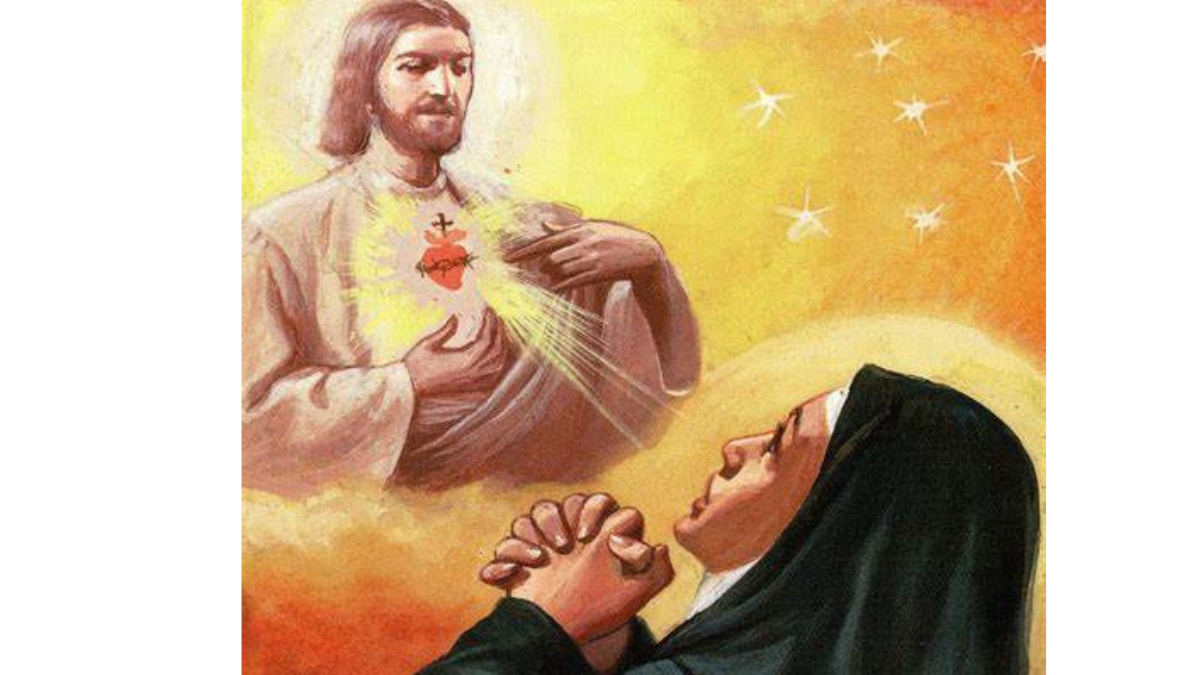
 Add to favorites
Add to favoritesSt. Margaret Mary Alacoque
| Feast day | September 25 |
| Patron | of Cork, Diocese of Cork |
| Birth | 550 |
| Death | 620 |
St. Margaret Mary Alacoque, a French Roman Catholic Visitation nun and mystic, is greatly recognized for her devotion to the Sacred Heart of Jesus.
She was born in 1647 in France as the only daughter of Claude and Philiberte Lamyn Alacoque. Margaret has always shown an intense love for the Blessed Sacrament and preferred silence over typical childhood play. She began practicing severe corporal mortification after her first communion at 9-years-old.
She continued this until rheumatic fever confined her to her bed for four years. After making a vow to the Blessed Virgin Mary to consecrate herself to religious life, Margaret instantly returned to perfect health. In recognition of this favor, Margaret added the name Mary to her baptismal name.
St. Margaret Mary Alacoque experienced visions of Jesus Christ for most of her life, but thought they were a normal part of life and continued to practice austerity.
After the death of her father, Margaret and her family were forced into poverty when a relative refused to hand over the family’s assets. Margaret’s only comfort in life was her frequent visits to pray before the Blessed Sacrament at a local church.
At 17-years-old, Margaret’s family was able to regain control of their assets. Margaret’s mother started encouraging her to become more social, in hopes she would find a suitable husband.
One night, after attending a ball in an evening dress, Margaret had a vision of Christ, scourged and bloody. He accused Margaret of forgetting about him. He showed her that His heart was full of love for her because of the promise she made to His Blessed Mother as a child. After this vision, Margaret was determined to fulfill the vow she made years ago. She entered the Visitation Convent at Paray-le-Monial in May 1671 to become a nun.
St. Margaret Mary was admitted to wearing the religious habit in August 1671 but was not officially admitted to profession until November 1672. Although she was described as humble, simple, kind and patient, Margaret had to prove the authenticity of her vocation.
During her time in this monastery, Margaret received several private revelations of the Sacred Heart of Jesus. These visions showed her the “form of the devotion, the chief features being reception of Holy Communion on the first Friday of each month, Eucharistic adoration during a ‘Holy hour’ on Thursdays, and the celebration of the Feast of the Sacred Heart.” The Lord Jesus requested His love be made evident through her.
In her vision, she was instructed to spend an hour every Thursday night meditating on Jesus’ Agony in the Garden of Gethsemane, a practice, known as “The Holy Hour,” that later became widespread.
In December 1673, Jesus appeared to Margaret Mary again, and allowed her to rest her head on His heart. His human heart was to be the symbol of His divine-human love. He revealed to her the wonders of His love. He explained to her that he wished to make these wonders known to all the world, and that He chose her for His work.
Margaret Mary convinced her superior, Mother de Saumaise, her visions were authentic. However, she struggled with convincing others of the validity of her apparitions, even those in her own community. A group of theologians declared her visions delusions and suggested she eat better. Even parents of children she instructed began calling her an imposter.
Margaret eventually gained the support from the community’s confessor, St. Claude de la Colombiere, who declared her visions were genuine. Finally, all opposition from the community, regarding Margaret’s visions, ended in 1683, when Margaret Mary became the assistant to the Superior.
St. Margaret Mary, who later became known as Novice Mistress, led the monastery in observing the Feast of the Sacred Heart privately, and inspired the construction of a chapel built to honor the Sacred Heart.
Margaret Mary died a couple of years later, at the age of 43, on October 17, 1690, while being anointed. She spoke the words, “I need nothing but God, and to lose myself in the heart of Jesus.”
After her death, the devotion to the Sacred Heart was adopted by the Jesuits but remained controversial within the Church. The practice did not become officially recognized until 75 years later.
St. Margaret Mary Alacoque was the topic of discussion long after hear death. People talked about her mission and qualities, her revelations and spiritual maxims and her teachings on the Sacred Heart. On September 18, 1864, Margaret Mary was beatified by Pope Pius IX. When her tomb was opened a few years later, two immediate cures took place and her body laid incorrupt.
St. Margaret Mary Alacoque was officially canonized on May 13, 1920 by Pope Benedict XV and, in 1928, Pope Pius XI upheld the Church’s position regarding the credibility behind her visions of Jesus Christ. He stated Jesus “manifested Himself” to Margaret and the chief features of devotion to the Sacred Heart are “reception of Holy Communion on the first Friday of each month, Eucharistic adoration during a ‘Holy hour’ on Thursdays, and the celebration of the Feast of the Sacred Heart.”
St. Margaret Mary Alacoque is the patron saint of devotees of the Sacred Heart, and those suffering with polio and from the loss of parents. Her feast day is celebrated on October 16. St. Margaret Mary Alacoque, a French Roman Catholic Visitation nun and mystic, is greatly recognized for her devotion to the Sacred Heart of Jesus.
She was born in 1647 in France as the only daughter of Claude and Philiberte Lamyn Alacoque. Margaret has always shown an intense love for the Blessed Sacrament and preferred silence over typical childhood play. She began practicing severe corporal mortification after her first communion at 9-years-old.
She continued this until rheumatic fever confined her to her bed for four years. After making a vow to the Blessed Virgin Mary to consecrate herself to religious life, Margaret instantly returned to perfect health. In recognition of this favor, Margaret added the name Mary to her baptismal name.
St. Margaret Mary Alacoque experienced visions of Jesus Christ for most of her life, but thought they were a normal part of life and continued to practice austerity.
After the death of her father, Margaret and her family were forced into poverty when a relative refused to hand over the family’s assets. Margaret’s only comfort in life was her frequent visits to pray before the Blessed Sacrament at a local church.
At 17-years-old, Margaret’s family was able to regain control of their assets. Margaret’s mother started encouraging her to become more social, in hopes she would find a suitable husband.
One night, after attending a ball in an evening dress, Margaret had a vision of Christ, scourged and bloody. He accused Margaret of forgetting about him. He showed her that His heart was full of love for her because of the promise she made to His Blessed Mother as a child. After this vision, Margaret was determined to fulfill the vow she made years ago. She entered the Visitation Convent at Paray-le-Monial in May 1671 to become a nun.
St. Margaret Mary was admitted to wearing the religious habit in August 1671 but was not officially admitted to profession until November 1672. Although she was described as humble, simple, kind and patient, Margaret had to prove the authenticity of her vocation.
During her time in this monastery, Margaret received several private revelations of the Sacred Heart of Jesus. These visions showed her the “form of the devotion, the chief features being reception of Holy Communion on the first Friday of each month, Eucharistic adoration during a ‘Holy hour’ on Thursdays, and the celebration of the Feast of the Sacred Heart.” The Lord Jesus requested His love be made evident through her.
In her vision, she was instructed to spend an hour every Thursday night meditating on Jesus’ Agony in the Garden of Gethsemane, a practice, known as “The Holy Hour,” that later became widespread.
In December 1673, Jesus appeared to Margaret Mary again, and allowed her to rest her head on His heart. His human heart was to be the symbol of His divine-human love. He revealed to her the wonders of His love. He explained to her that he wished to make these wonders known to all the world, and that He chose her for His work.
Margaret Mary convinced her superior, Mother de Saumaise, her visions were authentic. However, she struggled with convincing others of the validity of her apparitions, even those in her own community. A group of theologians declared her visions delusions and suggested she eat better. Even parents of children she instructed began calling her an imposter.
Margaret eventually gained the support from the community’s confessor, St. Claude de la Colombiere, who declared her visions were genuine. Finally, all opposition from the community, regarding Margaret’s visions, ended in 1683, when Margaret Mary became the assistant to the Superior.
St. Margaret Mary, who later became known as Novice Mistress, led the monastery in observing the Feast of the Sacred Heart privately, and inspired the construction of a chapel built to honor the Sacred Heart.
Margaret Mary died a couple of years later, at the age of 43, on October 17, 1690, while being anointed. She spoke the words, “I need nothing but God, and to lose myself in the heart of Jesus.”
After her death, the devotion to the Sacred Heart was adopted by the Jesuits but remained controversial within the Church. The practice did not become officially recognized until 75 years later.
St. Margaret Mary Alacoque was the topic of discussion long after hear death. People talked about her mission and qualities, her revelations and spiritual maxims and her teachings on the Sacred Heart. On September 18, 1864, Margaret Mary was beatified by Pope Pius IX. When her tomb was opened a few years later, two immediate cures took place and her body laid incorrupt.
St. Margaret Mary Alacoque was officially canonized on May 13, 1920 by Pope Benedict XV and, in 1928, Pope Pius XI upheld the Church’s position regarding the credibility behind her visions of Jesus Christ. He stated Jesus “manifested Himself” to Margaret and the chief features of devotion to the Sacred Heart are “reception of Holy Communion on the first Friday of each month, Eucharistic adoration during a ‘Holy hour’ on Thursdays, and the celebration of the Feast of the Sacred Heart.”
St. Margaret Mary Alacoque is the patron saint of devotees of the Sacred Heart, and those suffering with polio and from the loss of parents. Her feast day is celebrated on October 16.
Views: 15


